Management and Operations
VerifiedAdded on 2023/01/13
|12
|4226
|24
AI Summary
need ppt as well
Contribute Materials
Your contribution can guide someone’s learning journey. Share your
documents today.
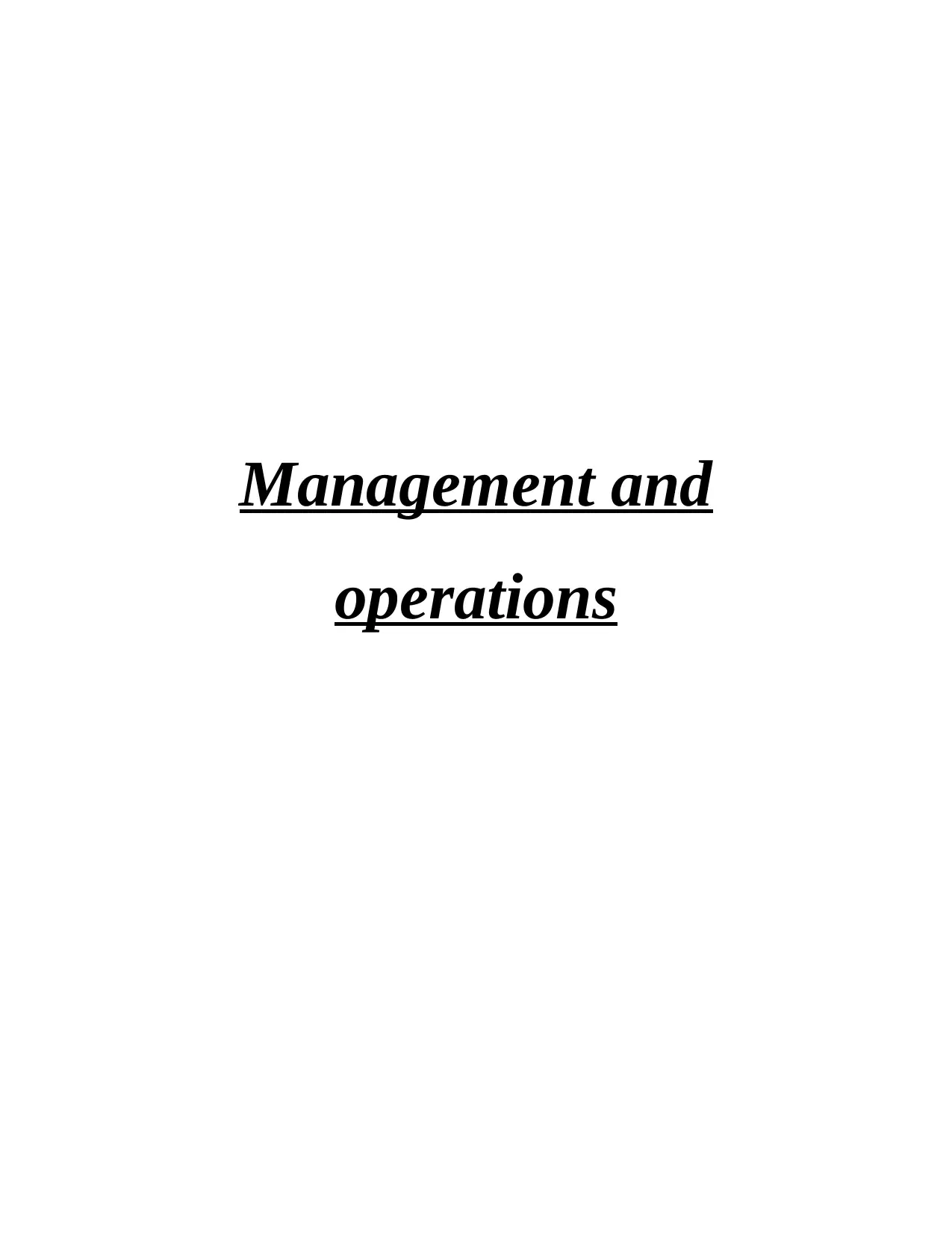
Management and
operations
operations
Secure Best Marks with AI Grader
Need help grading? Try our AI Grader for instant feedback on your assignments.
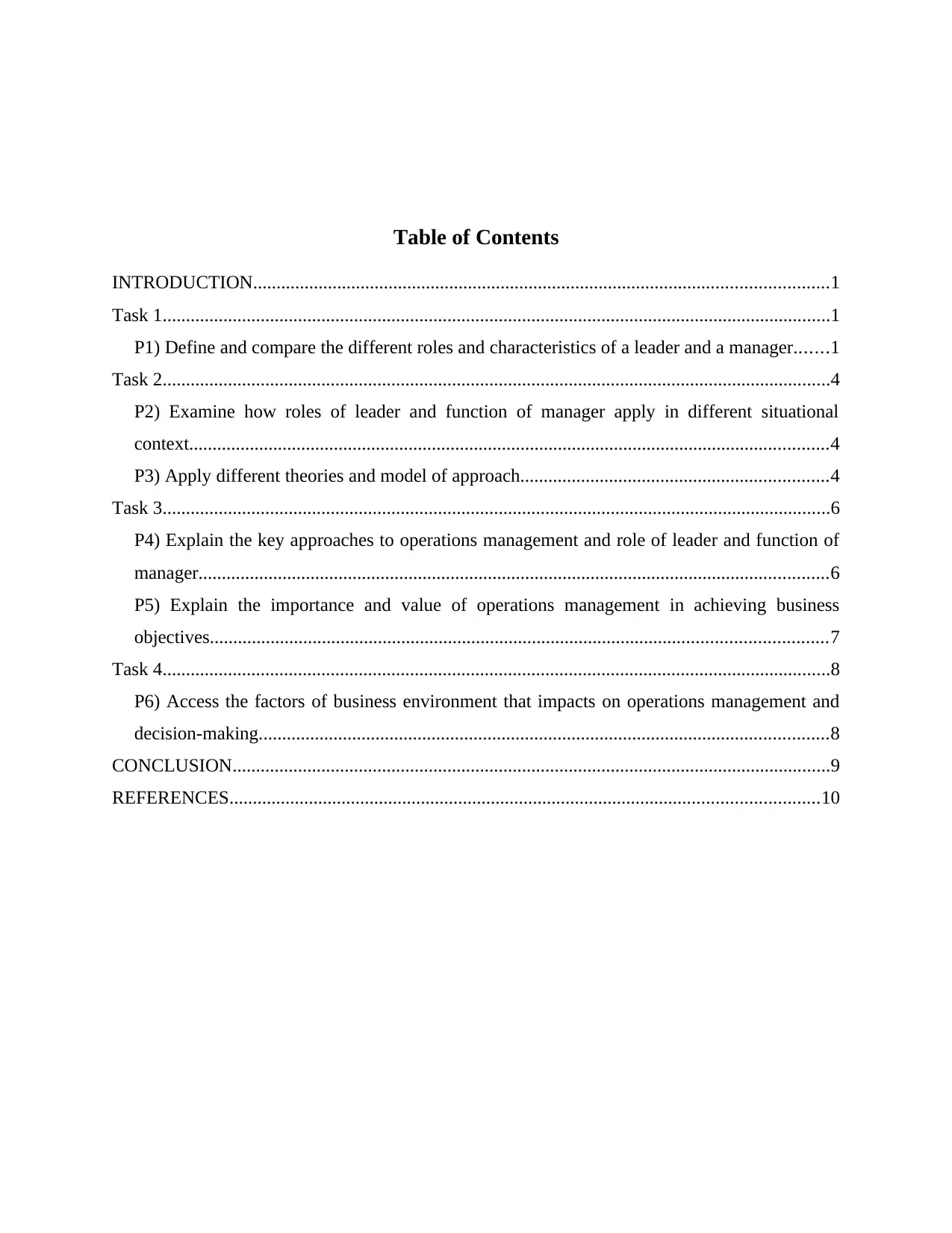
Table of Contents
INTRODUCTION...........................................................................................................................1
Task 1...............................................................................................................................................1
P1) Define and compare the different roles and characteristics of a leader and a manager.......1
Task 2...............................................................................................................................................4
P2) Examine how roles of leader and function of manager apply in different situational
context.........................................................................................................................................4
P3) Apply different theories and model of approach..................................................................4
Task 3...............................................................................................................................................6
P4) Explain the key approaches to operations management and role of leader and function of
manager.......................................................................................................................................6
P5) Explain the importance and value of operations management in achieving business
objectives....................................................................................................................................7
Task 4...............................................................................................................................................8
P6) Access the factors of business environment that impacts on operations management and
decision-making..........................................................................................................................8
CONCLUSION................................................................................................................................9
REFERENCES..............................................................................................................................10
INTRODUCTION...........................................................................................................................1
Task 1...............................................................................................................................................1
P1) Define and compare the different roles and characteristics of a leader and a manager.......1
Task 2...............................................................................................................................................4
P2) Examine how roles of leader and function of manager apply in different situational
context.........................................................................................................................................4
P3) Apply different theories and model of approach..................................................................4
Task 3...............................................................................................................................................6
P4) Explain the key approaches to operations management and role of leader and function of
manager.......................................................................................................................................6
P5) Explain the importance and value of operations management in achieving business
objectives....................................................................................................................................7
Task 4...............................................................................................................................................8
P6) Access the factors of business environment that impacts on operations management and
decision-making..........................................................................................................................8
CONCLUSION................................................................................................................................9
REFERENCES..............................................................................................................................10
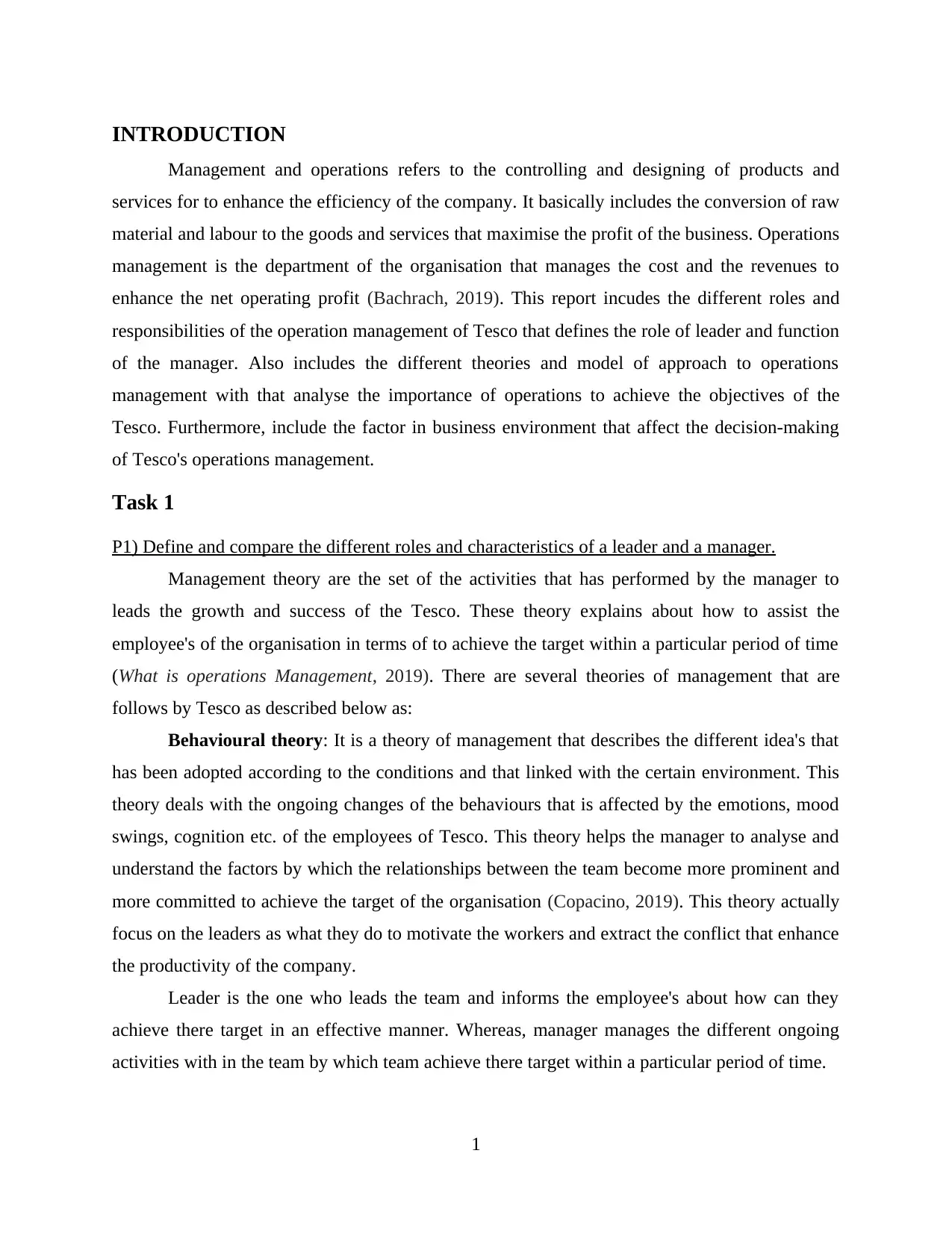
INTRODUCTION
Management and operations refers to the controlling and designing of products and
services for to enhance the efficiency of the company. It basically includes the conversion of raw
material and labour to the goods and services that maximise the profit of the business. Operations
management is the department of the organisation that manages the cost and the revenues to
enhance the net operating profit (Bachrach, 2019). This report incudes the different roles and
responsibilities of the operation management of Tesco that defines the role of leader and function
of the manager. Also includes the different theories and model of approach to operations
management with that analyse the importance of operations to achieve the objectives of the
Tesco. Furthermore, include the factor in business environment that affect the decision-making
of Tesco's operations management.
Task 1
P1) Define and compare the different roles and characteristics of a leader and a manager.
Management theory are the set of the activities that has performed by the manager to
leads the growth and success of the Tesco. These theory explains about how to assist the
employee's of the organisation in terms of to achieve the target within a particular period of time
(What is operations Management, 2019). There are several theories of management that are
follows by Tesco as described below as:
Behavioural theory: It is a theory of management that describes the different idea's that
has been adopted according to the conditions and that linked with the certain environment. This
theory deals with the ongoing changes of the behaviours that is affected by the emotions, mood
swings, cognition etc. of the employees of Tesco. This theory helps the manager to analyse and
understand the factors by which the relationships between the team become more prominent and
more committed to achieve the target of the organisation (Copacino, 2019). This theory actually
focus on the leaders as what they do to motivate the workers and extract the conflict that enhance
the productivity of the company.
Leader is the one who leads the team and informs the employee's about how can they
achieve there target in an effective manner. Whereas, manager manages the different ongoing
activities with in the team by which team achieve there target within a particular period of time.
1
Management and operations refers to the controlling and designing of products and
services for to enhance the efficiency of the company. It basically includes the conversion of raw
material and labour to the goods and services that maximise the profit of the business. Operations
management is the department of the organisation that manages the cost and the revenues to
enhance the net operating profit (Bachrach, 2019). This report incudes the different roles and
responsibilities of the operation management of Tesco that defines the role of leader and function
of the manager. Also includes the different theories and model of approach to operations
management with that analyse the importance of operations to achieve the objectives of the
Tesco. Furthermore, include the factor in business environment that affect the decision-making
of Tesco's operations management.
Task 1
P1) Define and compare the different roles and characteristics of a leader and a manager.
Management theory are the set of the activities that has performed by the manager to
leads the growth and success of the Tesco. These theory explains about how to assist the
employee's of the organisation in terms of to achieve the target within a particular period of time
(What is operations Management, 2019). There are several theories of management that are
follows by Tesco as described below as:
Behavioural theory: It is a theory of management that describes the different idea's that
has been adopted according to the conditions and that linked with the certain environment. This
theory deals with the ongoing changes of the behaviours that is affected by the emotions, mood
swings, cognition etc. of the employees of Tesco. This theory helps the manager to analyse and
understand the factors by which the relationships between the team become more prominent and
more committed to achieve the target of the organisation (Copacino, 2019). This theory actually
focus on the leaders as what they do to motivate the workers and extract the conflict that enhance
the productivity of the company.
Leader is the one who leads the team and informs the employee's about how can they
achieve there target in an effective manner. Whereas, manager manages the different ongoing
activities with in the team by which team achieve there target within a particular period of time.
1
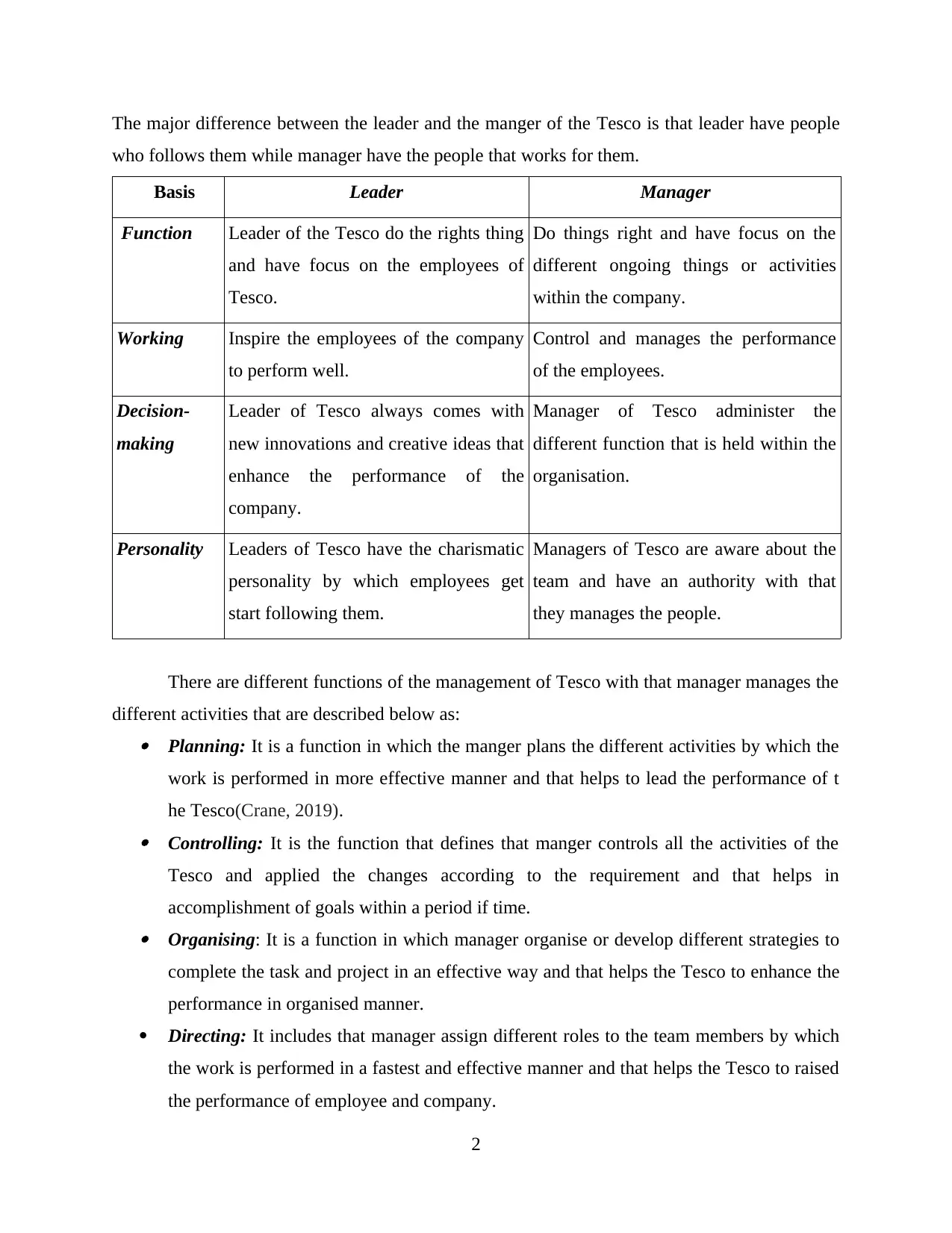
The major difference between the leader and the manger of the Tesco is that leader have people
who follows them while manager have the people that works for them.
Basis Leader Manager
Function Leader of the Tesco do the rights thing
and have focus on the employees of
Tesco.
Do things right and have focus on the
different ongoing things or activities
within the company.
Working Inspire the employees of the company
to perform well.
Control and manages the performance
of the employees.
Decision-
making
Leader of Tesco always comes with
new innovations and creative ideas that
enhance the performance of the
company.
Manager of Tesco administer the
different function that is held within the
organisation.
Personality Leaders of Tesco have the charismatic
personality by which employees get
start following them.
Managers of Tesco are aware about the
team and have an authority with that
they manages the people.
There are different functions of the management of Tesco with that manager manages the
different activities that are described below as: Planning: It is a function in which the manger plans the different activities by which the
work is performed in more effective manner and that helps to lead the performance of t
he Tesco(Crane, 2019). Controlling: It is the function that defines that manger controls all the activities of the
Tesco and applied the changes according to the requirement and that helps in
accomplishment of goals within a period if time. Organising: It is a function in which manager organise or develop different strategies to
complete the task and project in an effective way and that helps the Tesco to enhance the
performance in organised manner.
Directing: It includes that manager assign different roles to the team members by which
the work is performed in a fastest and effective manner and that helps the Tesco to raised
the performance of employee and company.
2
who follows them while manager have the people that works for them.
Basis Leader Manager
Function Leader of the Tesco do the rights thing
and have focus on the employees of
Tesco.
Do things right and have focus on the
different ongoing things or activities
within the company.
Working Inspire the employees of the company
to perform well.
Control and manages the performance
of the employees.
Decision-
making
Leader of Tesco always comes with
new innovations and creative ideas that
enhance the performance of the
company.
Manager of Tesco administer the
different function that is held within the
organisation.
Personality Leaders of Tesco have the charismatic
personality by which employees get
start following them.
Managers of Tesco are aware about the
team and have an authority with that
they manages the people.
There are different functions of the management of Tesco with that manager manages the
different activities that are described below as: Planning: It is a function in which the manger plans the different activities by which the
work is performed in more effective manner and that helps to lead the performance of t
he Tesco(Crane, 2019). Controlling: It is the function that defines that manger controls all the activities of the
Tesco and applied the changes according to the requirement and that helps in
accomplishment of goals within a period if time. Organising: It is a function in which manager organise or develop different strategies to
complete the task and project in an effective way and that helps the Tesco to enhance the
performance in organised manner.
Directing: It includes that manager assign different roles to the team members by which
the work is performed in a fastest and effective manner and that helps the Tesco to raised
the performance of employee and company.
2
Secure Best Marks with AI Grader
Need help grading? Try our AI Grader for instant feedback on your assignments.
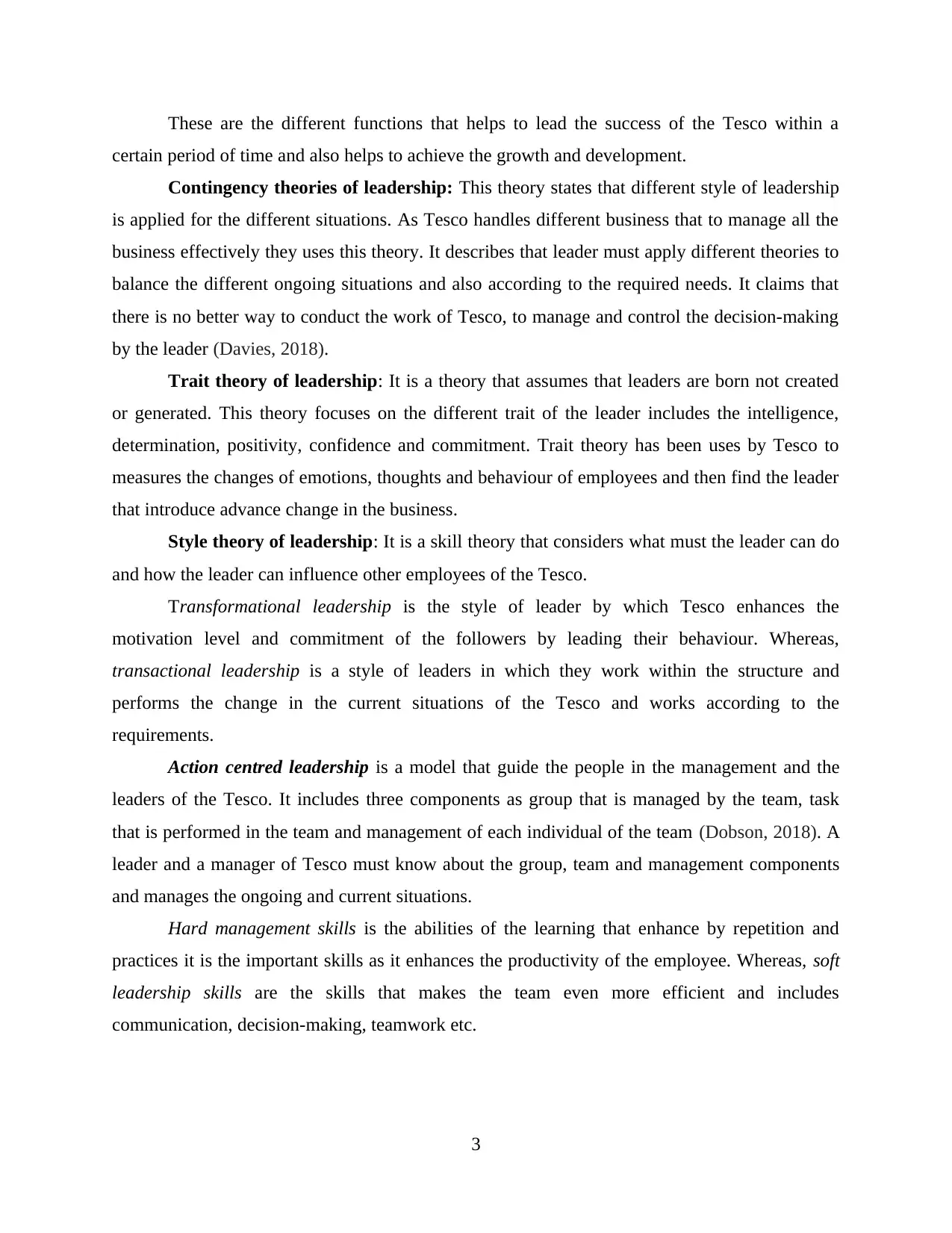
These are the different functions that helps to lead the success of the Tesco within a
certain period of time and also helps to achieve the growth and development.
Contingency theories of leadership: This theory states that different style of leadership
is applied for the different situations. As Tesco handles different business that to manage all the
business effectively they uses this theory. It describes that leader must apply different theories to
balance the different ongoing situations and also according to the required needs. It claims that
there is no better way to conduct the work of Tesco, to manage and control the decision-making
by the leader (Davies, 2018).
Trait theory of leadership: It is a theory that assumes that leaders are born not created
or generated. This theory focuses on the different trait of the leader includes the intelligence,
determination, positivity, confidence and commitment. Trait theory has been uses by Tesco to
measures the changes of emotions, thoughts and behaviour of employees and then find the leader
that introduce advance change in the business.
Style theory of leadership: It is a skill theory that considers what must the leader can do
and how the leader can influence other employees of the Tesco.
Transformational leadership is the style of leader by which Tesco enhances the
motivation level and commitment of the followers by leading their behaviour. Whereas,
transactional leadership is a style of leaders in which they work within the structure and
performs the change in the current situations of the Tesco and works according to the
requirements.
Action centred leadership is a model that guide the people in the management and the
leaders of the Tesco. It includes three components as group that is managed by the team, task
that is performed in the team and management of each individual of the team (Dobson, 2018). A
leader and a manager of Tesco must know about the group, team and management components
and manages the ongoing and current situations.
Hard management skills is the abilities of the learning that enhance by repetition and
practices it is the important skills as it enhances the productivity of the employee. Whereas, soft
leadership skills are the skills that makes the team even more efficient and includes
communication, decision-making, teamwork etc.
3
certain period of time and also helps to achieve the growth and development.
Contingency theories of leadership: This theory states that different style of leadership
is applied for the different situations. As Tesco handles different business that to manage all the
business effectively they uses this theory. It describes that leader must apply different theories to
balance the different ongoing situations and also according to the required needs. It claims that
there is no better way to conduct the work of Tesco, to manage and control the decision-making
by the leader (Davies, 2018).
Trait theory of leadership: It is a theory that assumes that leaders are born not created
or generated. This theory focuses on the different trait of the leader includes the intelligence,
determination, positivity, confidence and commitment. Trait theory has been uses by Tesco to
measures the changes of emotions, thoughts and behaviour of employees and then find the leader
that introduce advance change in the business.
Style theory of leadership: It is a skill theory that considers what must the leader can do
and how the leader can influence other employees of the Tesco.
Transformational leadership is the style of leader by which Tesco enhances the
motivation level and commitment of the followers by leading their behaviour. Whereas,
transactional leadership is a style of leaders in which they work within the structure and
performs the change in the current situations of the Tesco and works according to the
requirements.
Action centred leadership is a model that guide the people in the management and the
leaders of the Tesco. It includes three components as group that is managed by the team, task
that is performed in the team and management of each individual of the team (Dobson, 2018). A
leader and a manager of Tesco must know about the group, team and management components
and manages the ongoing and current situations.
Hard management skills is the abilities of the learning that enhance by repetition and
practices it is the important skills as it enhances the productivity of the employee. Whereas, soft
leadership skills are the skills that makes the team even more efficient and includes
communication, decision-making, teamwork etc.
3
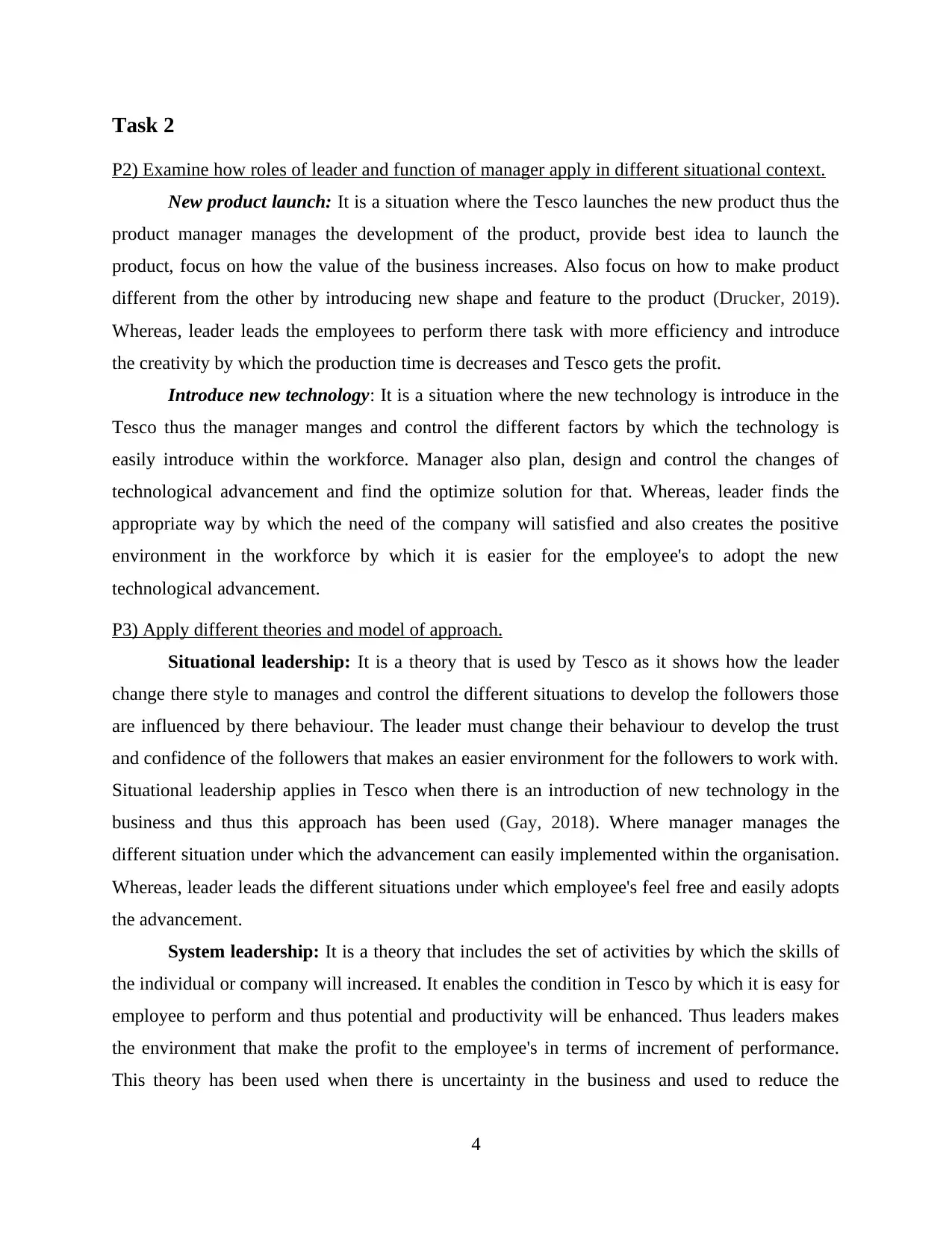
Task 2
P2) Examine how roles of leader and function of manager apply in different situational context.
New product launch: It is a situation where the Tesco launches the new product thus the
product manager manages the development of the product, provide best idea to launch the
product, focus on how the value of the business increases. Also focus on how to make product
different from the other by introducing new shape and feature to the product (Drucker, 2019).
Whereas, leader leads the employees to perform there task with more efficiency and introduce
the creativity by which the production time is decreases and Tesco gets the profit.
Introduce new technology: It is a situation where the new technology is introduce in the
Tesco thus the manager manges and control the different factors by which the technology is
easily introduce within the workforce. Manager also plan, design and control the changes of
technological advancement and find the optimize solution for that. Whereas, leader finds the
appropriate way by which the need of the company will satisfied and also creates the positive
environment in the workforce by which it is easier for the employee's to adopt the new
technological advancement.
P3) Apply different theories and model of approach.
Situational leadership: It is a theory that is used by Tesco as it shows how the leader
change there style to manages and control the different situations to develop the followers those
are influenced by there behaviour. The leader must change their behaviour to develop the trust
and confidence of the followers that makes an easier environment for the followers to work with.
Situational leadership applies in Tesco when there is an introduction of new technology in the
business and thus this approach has been used (Gay, 2018). Where manager manages the
different situation under which the advancement can easily implemented within the organisation.
Whereas, leader leads the different situations under which employee's feel free and easily adopts
the advancement.
System leadership: It is a theory that includes the set of activities by which the skills of
the individual or company will increased. It enables the condition in Tesco by which it is easy for
employee to perform and thus potential and productivity will be enhanced. Thus leaders makes
the environment that make the profit to the employee's in terms of increment of performance.
This theory has been used when there is uncertainty in the business and used to reduce the
4
P2) Examine how roles of leader and function of manager apply in different situational context.
New product launch: It is a situation where the Tesco launches the new product thus the
product manager manages the development of the product, provide best idea to launch the
product, focus on how the value of the business increases. Also focus on how to make product
different from the other by introducing new shape and feature to the product (Drucker, 2019).
Whereas, leader leads the employees to perform there task with more efficiency and introduce
the creativity by which the production time is decreases and Tesco gets the profit.
Introduce new technology: It is a situation where the new technology is introduce in the
Tesco thus the manager manges and control the different factors by which the technology is
easily introduce within the workforce. Manager also plan, design and control the changes of
technological advancement and find the optimize solution for that. Whereas, leader finds the
appropriate way by which the need of the company will satisfied and also creates the positive
environment in the workforce by which it is easier for the employee's to adopt the new
technological advancement.
P3) Apply different theories and model of approach.
Situational leadership: It is a theory that is used by Tesco as it shows how the leader
change there style to manages and control the different situations to develop the followers those
are influenced by there behaviour. The leader must change their behaviour to develop the trust
and confidence of the followers that makes an easier environment for the followers to work with.
Situational leadership applies in Tesco when there is an introduction of new technology in the
business and thus this approach has been used (Gay, 2018). Where manager manages the
different situation under which the advancement can easily implemented within the organisation.
Whereas, leader leads the different situations under which employee's feel free and easily adopts
the advancement.
System leadership: It is a theory that includes the set of activities by which the skills of
the individual or company will increased. It enables the condition in Tesco by which it is easy for
employee to perform and thus potential and productivity will be enhanced. Thus leaders makes
the environment that make the profit to the employee's in terms of increment of performance.
This theory has been used when there is uncertainty in the business and used to reduce the
4
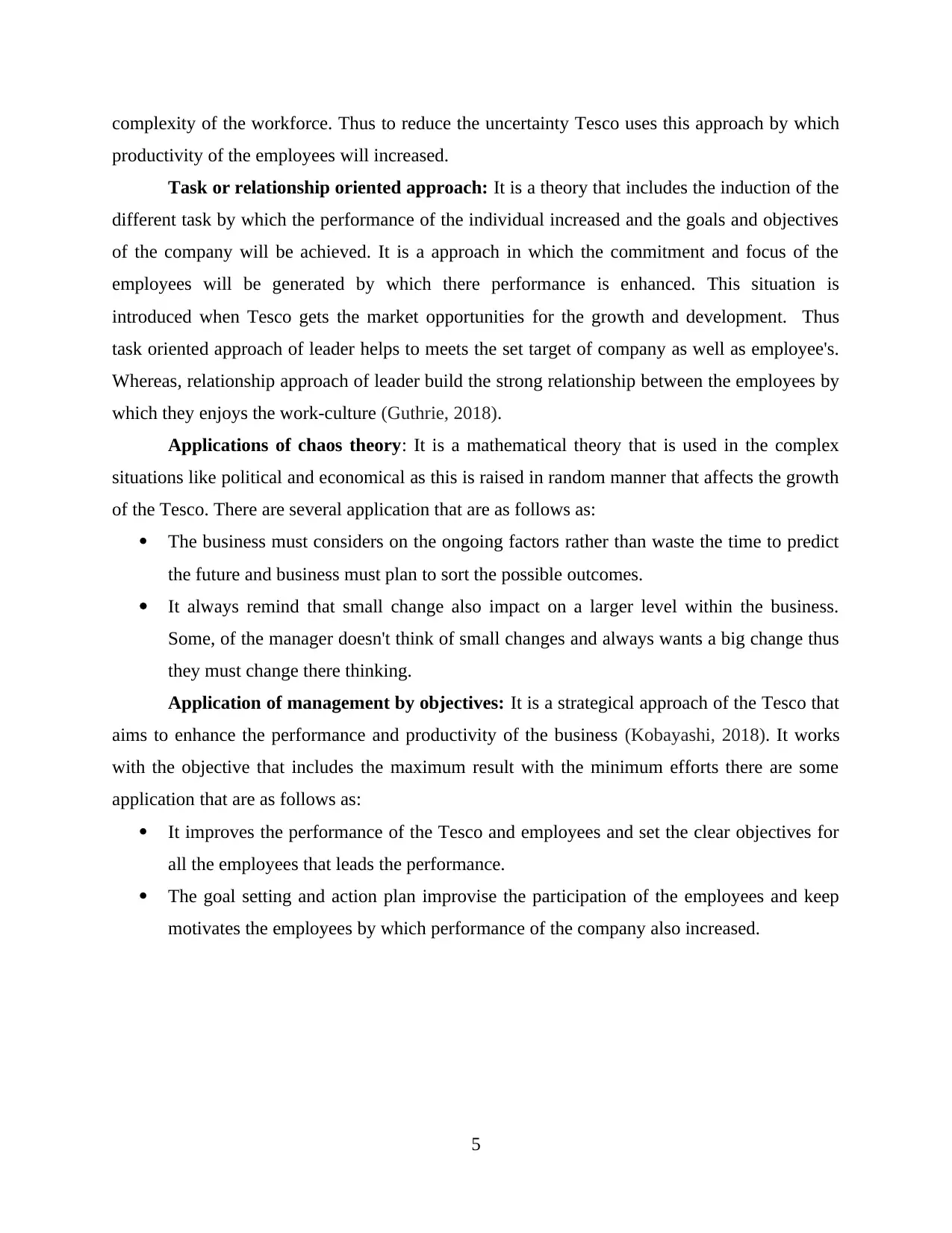
complexity of the workforce. Thus to reduce the uncertainty Tesco uses this approach by which
productivity of the employees will increased.
Task or relationship oriented approach: It is a theory that includes the induction of the
different task by which the performance of the individual increased and the goals and objectives
of the company will be achieved. It is a approach in which the commitment and focus of the
employees will be generated by which there performance is enhanced. This situation is
introduced when Tesco gets the market opportunities for the growth and development. Thus
task oriented approach of leader helps to meets the set target of company as well as employee's.
Whereas, relationship approach of leader build the strong relationship between the employees by
which they enjoys the work-culture (Guthrie, 2018).
Applications of chaos theory: It is a mathematical theory that is used in the complex
situations like political and economical as this is raised in random manner that affects the growth
of the Tesco. There are several application that are as follows as:
The business must considers on the ongoing factors rather than waste the time to predict
the future and business must plan to sort the possible outcomes.
It always remind that small change also impact on a larger level within the business.
Some, of the manager doesn't think of small changes and always wants a big change thus
they must change there thinking.
Application of management by objectives: It is a strategical approach of the Tesco that
aims to enhance the performance and productivity of the business (Kobayashi, 2018). It works
with the objective that includes the maximum result with the minimum efforts there are some
application that are as follows as:
It improves the performance of the Tesco and employees and set the clear objectives for
all the employees that leads the performance.
The goal setting and action plan improvise the participation of the employees and keep
motivates the employees by which performance of the company also increased.
5
productivity of the employees will increased.
Task or relationship oriented approach: It is a theory that includes the induction of the
different task by which the performance of the individual increased and the goals and objectives
of the company will be achieved. It is a approach in which the commitment and focus of the
employees will be generated by which there performance is enhanced. This situation is
introduced when Tesco gets the market opportunities for the growth and development. Thus
task oriented approach of leader helps to meets the set target of company as well as employee's.
Whereas, relationship approach of leader build the strong relationship between the employees by
which they enjoys the work-culture (Guthrie, 2018).
Applications of chaos theory: It is a mathematical theory that is used in the complex
situations like political and economical as this is raised in random manner that affects the growth
of the Tesco. There are several application that are as follows as:
The business must considers on the ongoing factors rather than waste the time to predict
the future and business must plan to sort the possible outcomes.
It always remind that small change also impact on a larger level within the business.
Some, of the manager doesn't think of small changes and always wants a big change thus
they must change there thinking.
Application of management by objectives: It is a strategical approach of the Tesco that
aims to enhance the performance and productivity of the business (Kobayashi, 2018). It works
with the objective that includes the maximum result with the minimum efforts there are some
application that are as follows as:
It improves the performance of the Tesco and employees and set the clear objectives for
all the employees that leads the performance.
The goal setting and action plan improvise the participation of the employees and keep
motivates the employees by which performance of the company also increased.
5
Paraphrase This Document
Need a fresh take? Get an instant paraphrase of this document with our AI Paraphraser
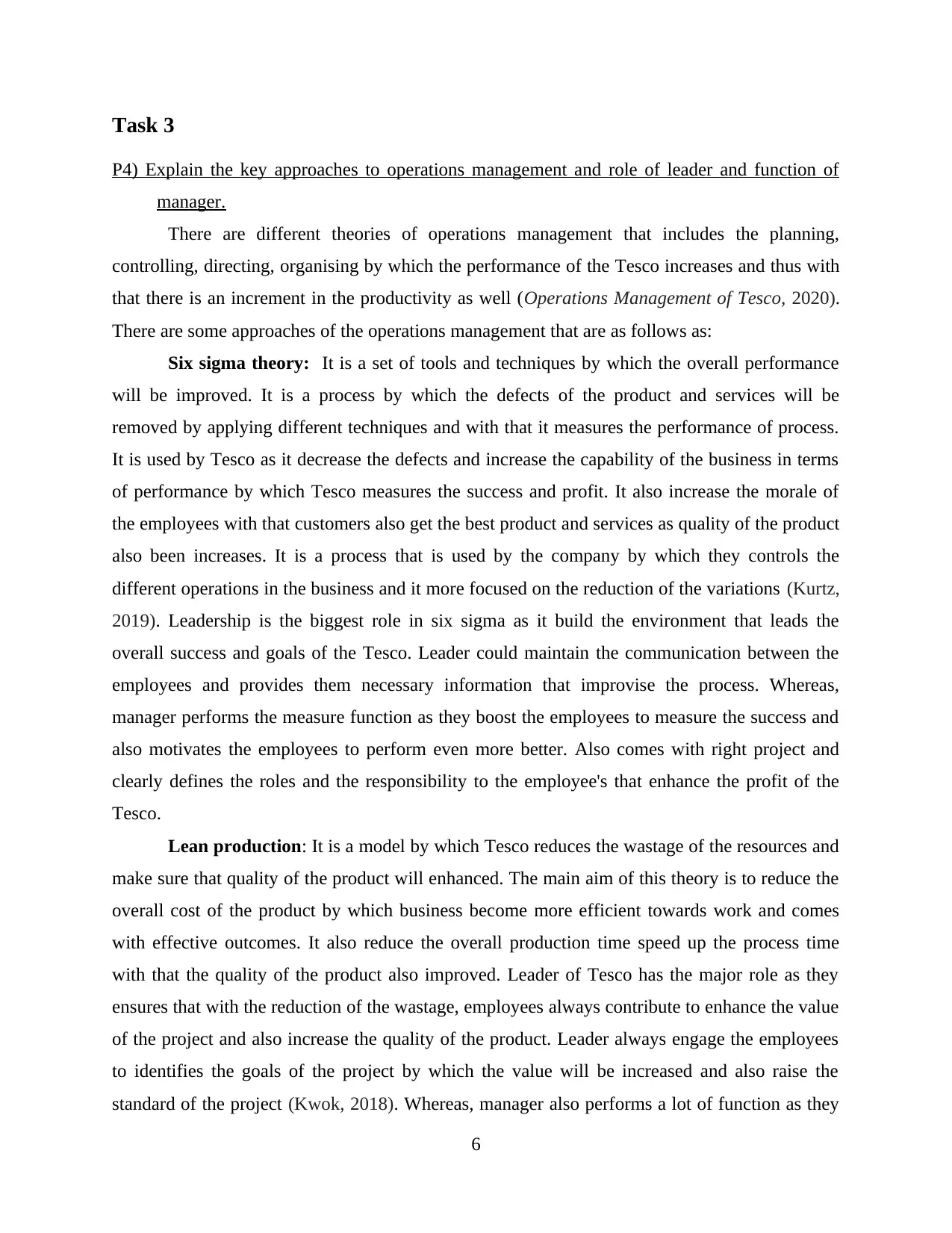
Task 3
P4) Explain the key approaches to operations management and role of leader and function of
manager.
There are different theories of operations management that includes the planning,
controlling, directing, organising by which the performance of the Tesco increases and thus with
that there is an increment in the productivity as well (Operations Management of Tesco, 2020).
There are some approaches of the operations management that are as follows as:
Six sigma theory: It is a set of tools and techniques by which the overall performance
will be improved. It is a process by which the defects of the product and services will be
removed by applying different techniques and with that it measures the performance of process.
It is used by Tesco as it decrease the defects and increase the capability of the business in terms
of performance by which Tesco measures the success and profit. It also increase the morale of
the employees with that customers also get the best product and services as quality of the product
also been increases. It is a process that is used by the company by which they controls the
different operations in the business and it more focused on the reduction of the variations (Kurtz,
2019). Leadership is the biggest role in six sigma as it build the environment that leads the
overall success and goals of the Tesco. Leader could maintain the communication between the
employees and provides them necessary information that improvise the process. Whereas,
manager performs the measure function as they boost the employees to measure the success and
also motivates the employees to perform even more better. Also comes with right project and
clearly defines the roles and the responsibility to the employee's that enhance the profit of the
Tesco.
Lean production: It is a model by which Tesco reduces the wastage of the resources and
make sure that quality of the product will enhanced. The main aim of this theory is to reduce the
overall cost of the product by which business become more efficient towards work and comes
with effective outcomes. It also reduce the overall production time speed up the process time
with that the quality of the product also improved. Leader of Tesco has the major role as they
ensures that with the reduction of the wastage, employees always contribute to enhance the value
of the project and also increase the quality of the product. Leader always engage the employees
to identifies the goals of the project by which the value will be increased and also raise the
standard of the project (Kwok, 2018). Whereas, manager also performs a lot of function as they
6
P4) Explain the key approaches to operations management and role of leader and function of
manager.
There are different theories of operations management that includes the planning,
controlling, directing, organising by which the performance of the Tesco increases and thus with
that there is an increment in the productivity as well (Operations Management of Tesco, 2020).
There are some approaches of the operations management that are as follows as:
Six sigma theory: It is a set of tools and techniques by which the overall performance
will be improved. It is a process by which the defects of the product and services will be
removed by applying different techniques and with that it measures the performance of process.
It is used by Tesco as it decrease the defects and increase the capability of the business in terms
of performance by which Tesco measures the success and profit. It also increase the morale of
the employees with that customers also get the best product and services as quality of the product
also been increases. It is a process that is used by the company by which they controls the
different operations in the business and it more focused on the reduction of the variations (Kurtz,
2019). Leadership is the biggest role in six sigma as it build the environment that leads the
overall success and goals of the Tesco. Leader could maintain the communication between the
employees and provides them necessary information that improvise the process. Whereas,
manager performs the measure function as they boost the employees to measure the success and
also motivates the employees to perform even more better. Also comes with right project and
clearly defines the roles and the responsibility to the employee's that enhance the profit of the
Tesco.
Lean production: It is a model by which Tesco reduces the wastage of the resources and
make sure that quality of the product will enhanced. The main aim of this theory is to reduce the
overall cost of the product by which business become more efficient towards work and comes
with effective outcomes. It also reduce the overall production time speed up the process time
with that the quality of the product also improved. Leader of Tesco has the major role as they
ensures that with the reduction of the wastage, employees always contribute to enhance the value
of the project and also increase the quality of the product. Leader always engage the employees
to identifies the goals of the project by which the value will be increased and also raise the
standard of the project (Kwok, 2018). Whereas, manager also performs a lot of function as they
6
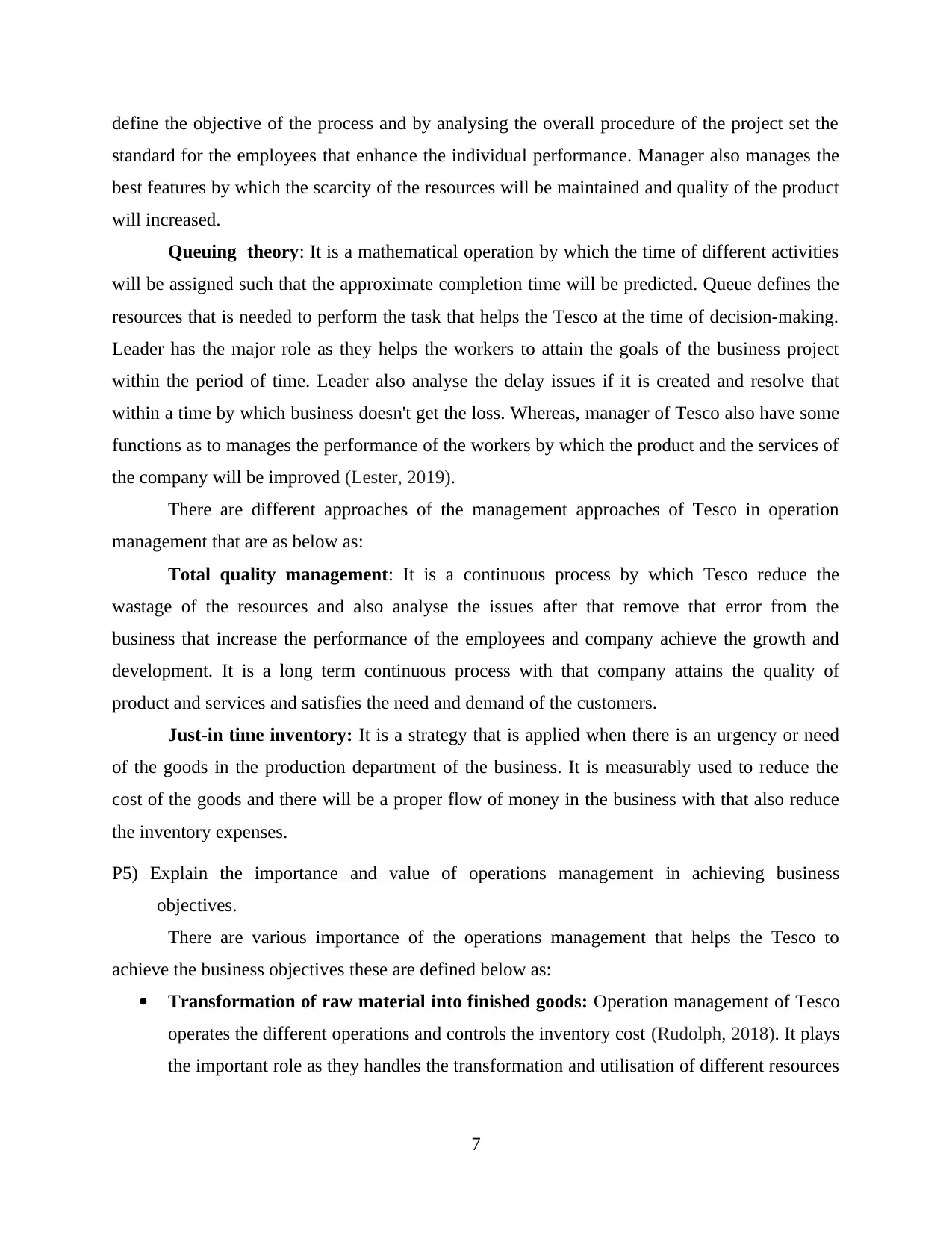
define the objective of the process and by analysing the overall procedure of the project set the
standard for the employees that enhance the individual performance. Manager also manages the
best features by which the scarcity of the resources will be maintained and quality of the product
will increased.
Queuing theory: It is a mathematical operation by which the time of different activities
will be assigned such that the approximate completion time will be predicted. Queue defines the
resources that is needed to perform the task that helps the Tesco at the time of decision-making.
Leader has the major role as they helps the workers to attain the goals of the business project
within the period of time. Leader also analyse the delay issues if it is created and resolve that
within a time by which business doesn't get the loss. Whereas, manager of Tesco also have some
functions as to manages the performance of the workers by which the product and the services of
the company will be improved (Lester, 2019).
There are different approaches of the management approaches of Tesco in operation
management that are as below as:
Total quality management: It is a continuous process by which Tesco reduce the
wastage of the resources and also analyse the issues after that remove that error from the
business that increase the performance of the employees and company achieve the growth and
development. It is a long term continuous process with that company attains the quality of
product and services and satisfies the need and demand of the customers.
Just-in time inventory: It is a strategy that is applied when there is an urgency or need
of the goods in the production department of the business. It is measurably used to reduce the
cost of the goods and there will be a proper flow of money in the business with that also reduce
the inventory expenses.
P5) Explain the importance and value of operations management in achieving business
objectives.
There are various importance of the operations management that helps the Tesco to
achieve the business objectives these are defined below as:
Transformation of raw material into finished goods: Operation management of Tesco
operates the different operations and controls the inventory cost (Rudolph, 2018). It plays
the important role as they handles the transformation and utilisation of different resources
7
standard for the employees that enhance the individual performance. Manager also manages the
best features by which the scarcity of the resources will be maintained and quality of the product
will increased.
Queuing theory: It is a mathematical operation by which the time of different activities
will be assigned such that the approximate completion time will be predicted. Queue defines the
resources that is needed to perform the task that helps the Tesco at the time of decision-making.
Leader has the major role as they helps the workers to attain the goals of the business project
within the period of time. Leader also analyse the delay issues if it is created and resolve that
within a time by which business doesn't get the loss. Whereas, manager of Tesco also have some
functions as to manages the performance of the workers by which the product and the services of
the company will be improved (Lester, 2019).
There are different approaches of the management approaches of Tesco in operation
management that are as below as:
Total quality management: It is a continuous process by which Tesco reduce the
wastage of the resources and also analyse the issues after that remove that error from the
business that increase the performance of the employees and company achieve the growth and
development. It is a long term continuous process with that company attains the quality of
product and services and satisfies the need and demand of the customers.
Just-in time inventory: It is a strategy that is applied when there is an urgency or need
of the goods in the production department of the business. It is measurably used to reduce the
cost of the goods and there will be a proper flow of money in the business with that also reduce
the inventory expenses.
P5) Explain the importance and value of operations management in achieving business
objectives.
There are various importance of the operations management that helps the Tesco to
achieve the business objectives these are defined below as:
Transformation of raw material into finished goods: Operation management of Tesco
operates the different operations and controls the inventory cost (Rudolph, 2018). It plays
the important role as they handles the transformation and utilisation of different resources
7
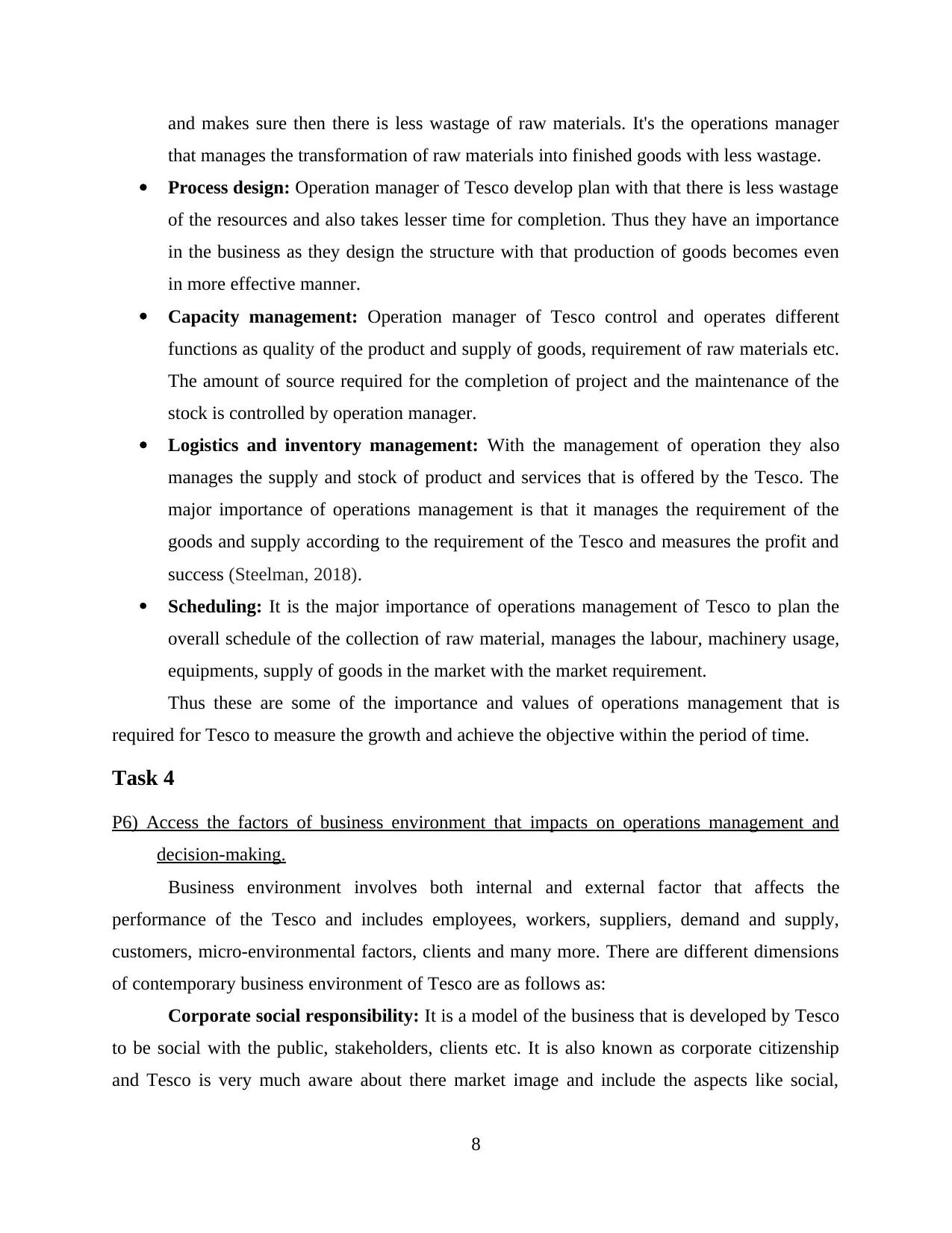
and makes sure then there is less wastage of raw materials. It's the operations manager
that manages the transformation of raw materials into finished goods with less wastage.
Process design: Operation manager of Tesco develop plan with that there is less wastage
of the resources and also takes lesser time for completion. Thus they have an importance
in the business as they design the structure with that production of goods becomes even
in more effective manner.
Capacity management: Operation manager of Tesco control and operates different
functions as quality of the product and supply of goods, requirement of raw materials etc.
The amount of source required for the completion of project and the maintenance of the
stock is controlled by operation manager.
Logistics and inventory management: With the management of operation they also
manages the supply and stock of product and services that is offered by the Tesco. The
major importance of operations management is that it manages the requirement of the
goods and supply according to the requirement of the Tesco and measures the profit and
success (Steelman, 2018).
Scheduling: It is the major importance of operations management of Tesco to plan the
overall schedule of the collection of raw material, manages the labour, machinery usage,
equipments, supply of goods in the market with the market requirement.
Thus these are some of the importance and values of operations management that is
required for Tesco to measure the growth and achieve the objective within the period of time.
Task 4
P6) Access the factors of business environment that impacts on operations management and
decision-making.
Business environment involves both internal and external factor that affects the
performance of the Tesco and includes employees, workers, suppliers, demand and supply,
customers, micro-environmental factors, clients and many more. There are different dimensions
of contemporary business environment of Tesco are as follows as:
Corporate social responsibility: It is a model of the business that is developed by Tesco
to be social with the public, stakeholders, clients etc. It is also known as corporate citizenship
and Tesco is very much aware about there market image and include the aspects like social,
8
that manages the transformation of raw materials into finished goods with less wastage.
Process design: Operation manager of Tesco develop plan with that there is less wastage
of the resources and also takes lesser time for completion. Thus they have an importance
in the business as they design the structure with that production of goods becomes even
in more effective manner.
Capacity management: Operation manager of Tesco control and operates different
functions as quality of the product and supply of goods, requirement of raw materials etc.
The amount of source required for the completion of project and the maintenance of the
stock is controlled by operation manager.
Logistics and inventory management: With the management of operation they also
manages the supply and stock of product and services that is offered by the Tesco. The
major importance of operations management is that it manages the requirement of the
goods and supply according to the requirement of the Tesco and measures the profit and
success (Steelman, 2018).
Scheduling: It is the major importance of operations management of Tesco to plan the
overall schedule of the collection of raw material, manages the labour, machinery usage,
equipments, supply of goods in the market with the market requirement.
Thus these are some of the importance and values of operations management that is
required for Tesco to measure the growth and achieve the objective within the period of time.
Task 4
P6) Access the factors of business environment that impacts on operations management and
decision-making.
Business environment involves both internal and external factor that affects the
performance of the Tesco and includes employees, workers, suppliers, demand and supply,
customers, micro-environmental factors, clients and many more. There are different dimensions
of contemporary business environment of Tesco are as follows as:
Corporate social responsibility: It is a model of the business that is developed by Tesco
to be social with the public, stakeholders, clients etc. It is also known as corporate citizenship
and Tesco is very much aware about there market image and include the aspects like social,
8
Secure Best Marks with AI Grader
Need help grading? Try our AI Grader for instant feedback on your assignments.
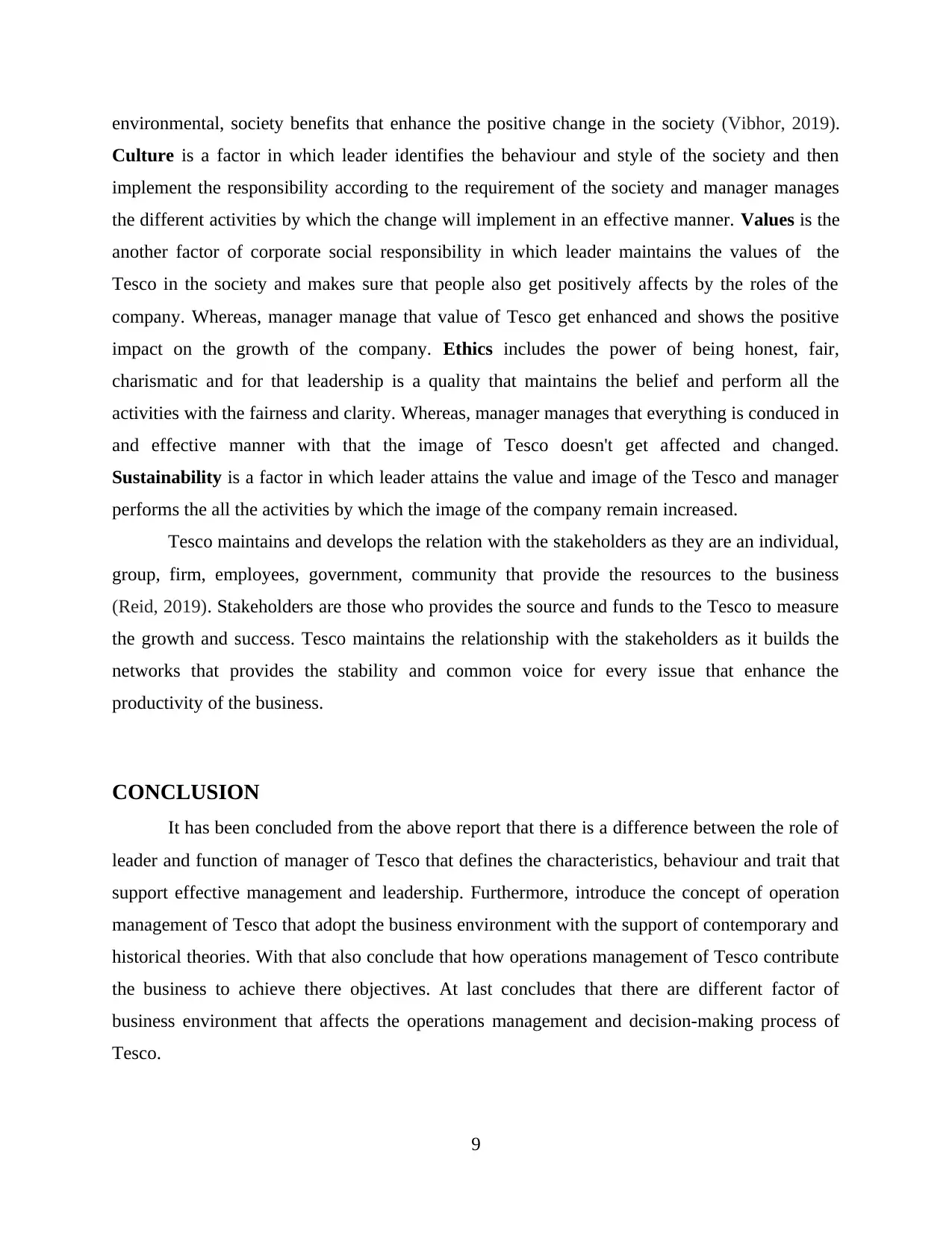
environmental, society benefits that enhance the positive change in the society (Vibhor, 2019).
Culture is a factor in which leader identifies the behaviour and style of the society and then
implement the responsibility according to the requirement of the society and manager manages
the different activities by which the change will implement in an effective manner. Values is the
another factor of corporate social responsibility in which leader maintains the values of the
Tesco in the society and makes sure that people also get positively affects by the roles of the
company. Whereas, manager manage that value of Tesco get enhanced and shows the positive
impact on the growth of the company. Ethics includes the power of being honest, fair,
charismatic and for that leadership is a quality that maintains the belief and perform all the
activities with the fairness and clarity. Whereas, manager manages that everything is conduced in
and effective manner with that the image of Tesco doesn't get affected and changed.
Sustainability is a factor in which leader attains the value and image of the Tesco and manager
performs the all the activities by which the image of the company remain increased.
Tesco maintains and develops the relation with the stakeholders as they are an individual,
group, firm, employees, government, community that provide the resources to the business
(Reid, 2019). Stakeholders are those who provides the source and funds to the Tesco to measure
the growth and success. Tesco maintains the relationship with the stakeholders as it builds the
networks that provides the stability and common voice for every issue that enhance the
productivity of the business.
CONCLUSION
It has been concluded from the above report that there is a difference between the role of
leader and function of manager of Tesco that defines the characteristics, behaviour and trait that
support effective management and leadership. Furthermore, introduce the concept of operation
management of Tesco that adopt the business environment with the support of contemporary and
historical theories. With that also conclude that how operations management of Tesco contribute
the business to achieve there objectives. At last concludes that there are different factor of
business environment that affects the operations management and decision-making process of
Tesco.
9
Culture is a factor in which leader identifies the behaviour and style of the society and then
implement the responsibility according to the requirement of the society and manager manages
the different activities by which the change will implement in an effective manner. Values is the
another factor of corporate social responsibility in which leader maintains the values of the
Tesco in the society and makes sure that people also get positively affects by the roles of the
company. Whereas, manager manage that value of Tesco get enhanced and shows the positive
impact on the growth of the company. Ethics includes the power of being honest, fair,
charismatic and for that leadership is a quality that maintains the belief and perform all the
activities with the fairness and clarity. Whereas, manager manages that everything is conduced in
and effective manner with that the image of Tesco doesn't get affected and changed.
Sustainability is a factor in which leader attains the value and image of the Tesco and manager
performs the all the activities by which the image of the company remain increased.
Tesco maintains and develops the relation with the stakeholders as they are an individual,
group, firm, employees, government, community that provide the resources to the business
(Reid, 2019). Stakeholders are those who provides the source and funds to the Tesco to measure
the growth and success. Tesco maintains the relationship with the stakeholders as it builds the
networks that provides the stability and common voice for every issue that enhance the
productivity of the business.
CONCLUSION
It has been concluded from the above report that there is a difference between the role of
leader and function of manager of Tesco that defines the characteristics, behaviour and trait that
support effective management and leadership. Furthermore, introduce the concept of operation
management of Tesco that adopt the business environment with the support of contemporary and
historical theories. With that also conclude that how operations management of Tesco contribute
the business to achieve there objectives. At last concludes that there are different factor of
business environment that affects the operations management and decision-making process of
Tesco.
9
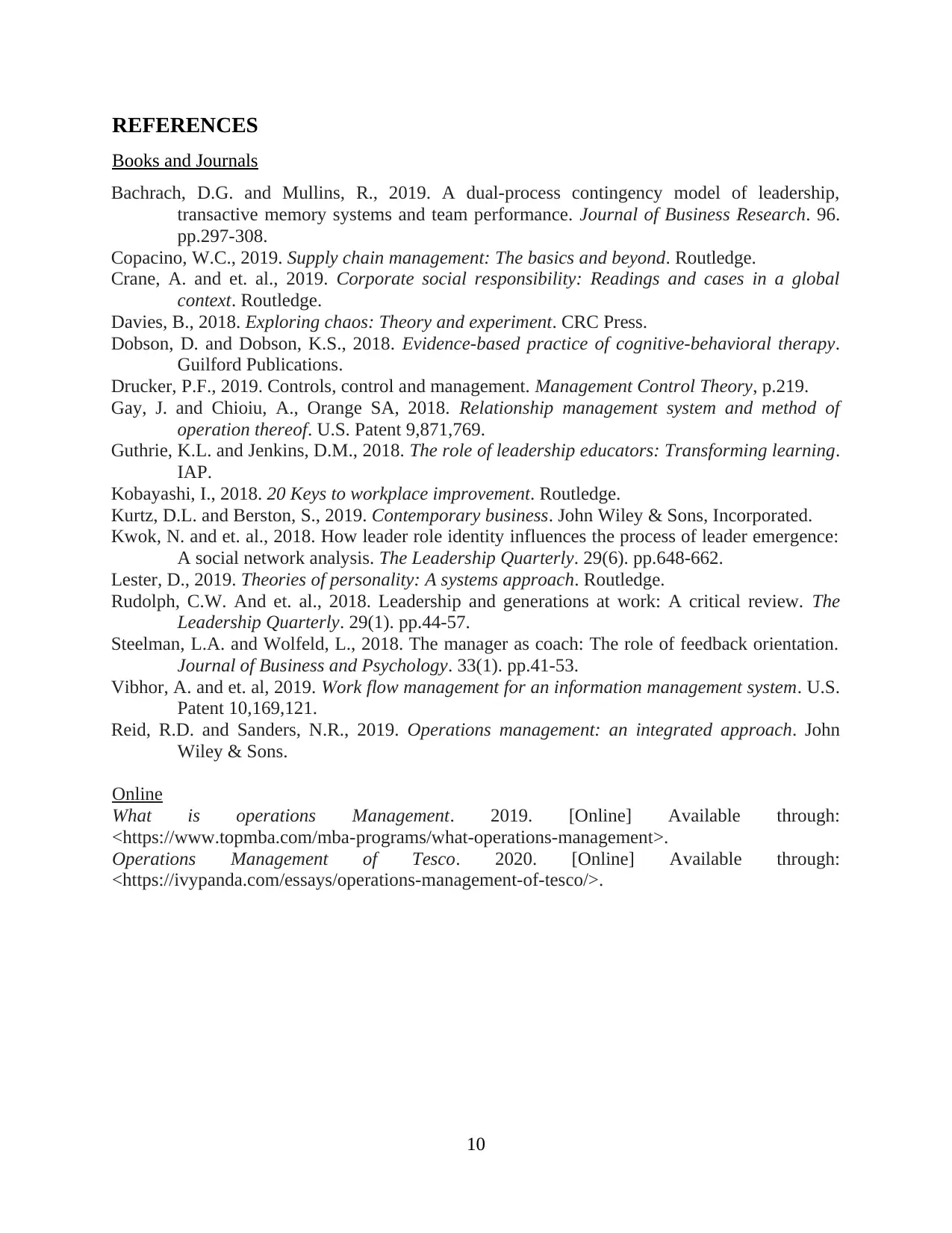
REFERENCES
Books and Journals
Bachrach, D.G. and Mullins, R., 2019. A dual-process contingency model of leadership,
transactive memory systems and team performance. Journal of Business Research. 96.
pp.297-308.
Copacino, W.C., 2019. Supply chain management: The basics and beyond. Routledge.
Crane, A. and et. al., 2019. Corporate social responsibility: Readings and cases in a global
context. Routledge.
Davies, B., 2018. Exploring chaos: Theory and experiment. CRC Press.
Dobson, D. and Dobson, K.S., 2018. Evidence-based practice of cognitive-behavioral therapy.
Guilford Publications.
Drucker, P.F., 2019. Controls, control and management. Management Control Theory, p.219.
Gay, J. and Chioiu, A., Orange SA, 2018. Relationship management system and method of
operation thereof. U.S. Patent 9,871,769.
Guthrie, K.L. and Jenkins, D.M., 2018. The role of leadership educators: Transforming learning.
IAP.
Kobayashi, I., 2018. 20 Keys to workplace improvement. Routledge.
Kurtz, D.L. and Berston, S., 2019. Contemporary business. John Wiley & Sons, Incorporated.
Kwok, N. and et. al., 2018. How leader role identity influences the process of leader emergence:
A social network analysis. The Leadership Quarterly. 29(6). pp.648-662.
Lester, D., 2019. Theories of personality: A systems approach. Routledge.
Rudolph, C.W. And et. al., 2018. Leadership and generations at work: A critical review. The
Leadership Quarterly. 29(1). pp.44-57.
Steelman, L.A. and Wolfeld, L., 2018. The manager as coach: The role of feedback orientation.
Journal of Business and Psychology. 33(1). pp.41-53.
Vibhor, A. and et. al, 2019. Work flow management for an information management system. U.S.
Patent 10,169,121.
Reid, R.D. and Sanders, N.R., 2019. Operations management: an integrated approach. John
Wiley & Sons.
Online
What is operations Management. 2019. [Online] Available through:
<https://www.topmba.com/mba-programs/what-operations-management>.
Operations Management of Tesco. 2020. [Online] Available through:
<https://ivypanda.com/essays/operations-management-of-tesco/>.
10
Books and Journals
Bachrach, D.G. and Mullins, R., 2019. A dual-process contingency model of leadership,
transactive memory systems and team performance. Journal of Business Research. 96.
pp.297-308.
Copacino, W.C., 2019. Supply chain management: The basics and beyond. Routledge.
Crane, A. and et. al., 2019. Corporate social responsibility: Readings and cases in a global
context. Routledge.
Davies, B., 2018. Exploring chaos: Theory and experiment. CRC Press.
Dobson, D. and Dobson, K.S., 2018. Evidence-based practice of cognitive-behavioral therapy.
Guilford Publications.
Drucker, P.F., 2019. Controls, control and management. Management Control Theory, p.219.
Gay, J. and Chioiu, A., Orange SA, 2018. Relationship management system and method of
operation thereof. U.S. Patent 9,871,769.
Guthrie, K.L. and Jenkins, D.M., 2018. The role of leadership educators: Transforming learning.
IAP.
Kobayashi, I., 2018. 20 Keys to workplace improvement. Routledge.
Kurtz, D.L. and Berston, S., 2019. Contemporary business. John Wiley & Sons, Incorporated.
Kwok, N. and et. al., 2018. How leader role identity influences the process of leader emergence:
A social network analysis. The Leadership Quarterly. 29(6). pp.648-662.
Lester, D., 2019. Theories of personality: A systems approach. Routledge.
Rudolph, C.W. And et. al., 2018. Leadership and generations at work: A critical review. The
Leadership Quarterly. 29(1). pp.44-57.
Steelman, L.A. and Wolfeld, L., 2018. The manager as coach: The role of feedback orientation.
Journal of Business and Psychology. 33(1). pp.41-53.
Vibhor, A. and et. al, 2019. Work flow management for an information management system. U.S.
Patent 10,169,121.
Reid, R.D. and Sanders, N.R., 2019. Operations management: an integrated approach. John
Wiley & Sons.
Online
What is operations Management. 2019. [Online] Available through:
<https://www.topmba.com/mba-programs/what-operations-management>.
Operations Management of Tesco. 2020. [Online] Available through:
<https://ivypanda.com/essays/operations-management-of-tesco/>.
10
1 out of 12
Related Documents
Your All-in-One AI-Powered Toolkit for Academic Success.
+13062052269
info@desklib.com
Available 24*7 on WhatsApp / Email
![[object Object]](/_next/static/media/star-bottom.7253800d.svg)
Unlock your academic potential
© 2024 | Zucol Services PVT LTD | All rights reserved.





